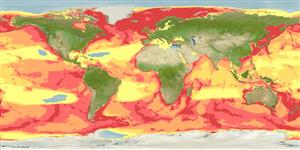Common names from other countries
Classification / Names / Names
Namen | Synonyme | Catalog of Fishes (gen., sp.) | ITIS | CoL | WoRMS
Environment: milieu / climate zone / depth range / distribution range
Ökologie
; brackwasser; tiefenbereich 0 - 732 m (Ref. 116169). Tropical; 90°N - 90°S, 180°W - 180°E
Circumglobal: Balaenoptera acutorostrata acutorostrata: North Atlantic; Balaenoptera acutorostrata scammoni: North Pacific (Ref. 1522).
Length at first maturity / Size / Gewicht / Alter
Maturity: Lm ? range ? - ? cm Max length : 1,070 cm TL Männchen/unbestimmt; (Ref. 1394); 1070 cm TL (female); max. veröff. Gewicht: 14.0 t (Ref. 1394)
Distributed from the tropics to the ice edges in both hemispheres. They can be seen offshore, and more often in coastal and inshore areas. They are rarely seen in some tropical pelagic areas. Minimum depth from the Pacific (Ref. 83490) and maximum depth based from their food in the Atlantic (Ref. 83488). Feeds on krill and small schooling fishes (Ref. 1394). Oceanodromous (Ref. 75906). Distributed from the tropics to the ice edges in both hemispheres. They can be seen offshore, and more often in coastal and inshore areas. They are rarely seen in some tropical pelagic areas (Ref. 1394). They are known to be 'gulpers,' feeding in separate events, often lunging at large schools of fish (Ref. 122680). Also feeds on krill (Ref. 1394). Oceanodromous (Ref. 75906).
Jefferson, T.A., S. Leatherwood and M.A. Webber. 1993. (Ref. 1394)
IUCN Rote Liste Status (Ref. 130435)
CITES Status (Ref. 108899)
Not Evaluated
Nutzung durch Menschen
Fischereien: kommerziell
FAO - Fischereien: landings, Artbeschreibung | FishSource | Sea Around Us
Tools
Internet Quellen
Estimates based on models
Preferred temperature
(Ref.
115969): 0.2 - 11.2, mean 2.9 (based on 10218 cells).
Widerstandsfähigkeit
mittel, Verdopplung der Population dauert 1,4 - 4,4 Jahre. (K=0.17; tm=8).
Verwundbarkeit
High vulnerability (63 of 100).
Preiskategorie
Unknown.
